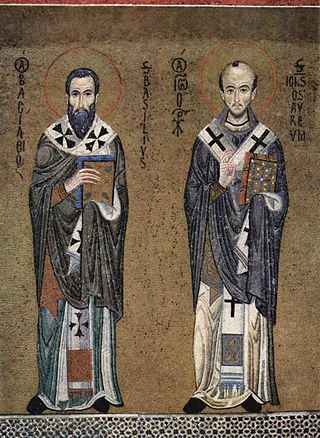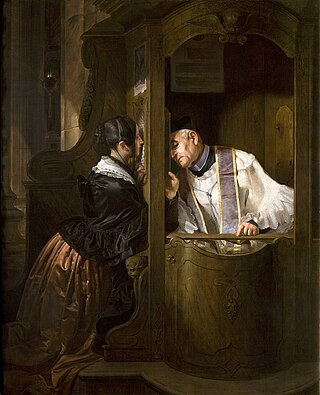Related Research Articles

The Tridentine Mass, also known as the Traditional Latin Mass or the Traditional Rite, is the liturgy in the Roman Missal of the Catholic Church codified in 1570 and published thereafter with amendments up to 1962. Celebrated almost exclusively in Ecclesiastical Latin, it was the most widely used Eucharistic liturgy in the world from its issuance in 1570 until the introduction of the Mass of Paul VI.

Divine Liturgy or Holy Liturgy is the usual name used in most Eastern Christian rites for the Eucharistic service.
The Good Friday prayer for the Jews is an annual prayer in some Christian liturgies. It is one of several petitions, known in the Catholic Church as the Solemn Intercessions and in the Episcopal Church as the Solemn Collects, that are made in the Good Friday service for various classes and stations of peoples: for the Church; for the pope; for bishops, priests and deacons; for the faithful; for catechumens; for other Christians; for the Jews; for others who do not believe in Christ; for those who do not believe in God; for those in public office; and for those in special need. These prayers are ancient, predating the eighth century at least, as they are found in the Gelasian Sacramentary.

The epiclesis refers to the invocation of one or several gods. In ancient Greek religion, the epiclesis was the epithet used as the surname given to a deity in religious contexts. The term was borrowed into the Christian tradition, where it designates the part of the Anaphora by which the priest invokes the Holy Spirit upon the Eucharistic bread and wine in some Christian churches. In most Eastern Christian traditions, the Epiclesis comes after the Anamnesis ; in the Western Rite it usually precedes. In the historic practice of the Western Christian Churches, the consecration is effected at the Words of Institution though during the rise of the Liturgical Movement, many denominations introduced an explicit epiclesis in their liturgies.
The Sanctus is a hymn in Christian liturgy. It may also be called the epinikios hymnos when referring to the Greek rendition and parts of it are sometimes called "Benedictus". Tersanctus is another, rarer name for the Sanctus. The same name is sometimes used for the Trisagion.

Absolution is a theological term for the forgiveness imparted by ordained Christian priests and experienced by Christian penitents. It is a universal feature of the historic churches of Christendom, although the theology and the practice of absolution vary between Christian denominations.

The Exsultet, also known as the Easter Proclamation, is a lengthy sung proclamation delivered before the paschal candle, ideally by a deacon, during the Easter Vigil in the Roman Rite of Mass. In the absence of a deacon, it may be sung by a priest or by a cantor. It is sung after a procession with the paschal candle before the beginning of the Liturgy of the Word. It is also used in Anglican and various Lutheran churches, as well as other Western Christian denominations.

The Anaphora is the most solemn part of the Eucharistic liturgies, such as the Divine Liturgy or the Mass, which serves as a thanksgiving prayer by virtue of which the offerings of bread and wine are consecrated as the body and blood of Christ. This is the usual name for this part of the Liturgy in Greek-speaking Eastern Christianity. In the Eastern Syriac tradition Qudaša is its equivalent. The corresponding part in western Christian liturgy is nowadays most often called the Eucharistic Prayer. The Roman Rite from the 4th century until after Vatican II had a single such prayer, called the Canon of the Mass.

In Eastern Orthodox and Byzantine Catholic churches, an entrance is a procession during which the clergy enter into the sanctuary through the Holy Doors. The origin of these entrances goes back to the early church, when the liturgical books and sacred vessels were kept in special storage rooms for safe keeping and the procession was necessary to bring these objects into the church when needed. Over the centuries, these processions have grown more elaborate, and nowadays are accompanied by incense, candles and liturgical fans. In the liturgical theology of the Eastern Orthodox Church, the angels are believed to enter with the clergy into the sanctuary, as evidenced by the prayers which accompany the various entrances.
Dóminus vobíscum is an ancient salutation and blessing traditionally used by the clergy in the Masses of the Catholic Church and other liturgies, as well as liturgies of other Western Christian denominations, such as Lutheranism, Anglicanism and Methodism.

Antiochene Rite also known as Antiochian Rite refers to the family of liturgies originally used by the patriarch of Antioch.
The Sursum corda is the opening dialogue to the Preface of the Eucharistic Prayer or Anaphora in Christian liturgies, dating back at least to the third century and the Anaphora of the Apostolic Tradition. The dialogue is recorded in the earliest liturgies of the Catholic Church in the west and east, and is found in all ancient rites.
The Divine Service is a title given to the Eucharistic liturgy as used in the various Lutheran churches. It has its roots in the Pre-Tridentine Mass as revised by Martin Luther in his Formula missae of 1523 and his Deutsche Messe of 1526. It was further developed through the Kirchenordnungen of the sixteenth and seventeenth centuries that followed in Luther's tradition.
In Christian liturgical worship, Preces, also known in Anglican prayer as the Suffrages or Responses, are short petitions said or sung as versicles and responses by the officiant and congregation respectively. Versicle-and-response is one of the oldest forms of prayer in Christianity, with its roots in Hebrew prayer during the time of the Temple in Jerusalem. In many prayer books the versicles and responses comprising the Preces are denoted by special glyphs:

In Eastern and Western Christian liturgical practice, the elevation is a ritual raising of the consecrated Sacred Body and Blood of Christ during the celebration of the Eucharist. The term is applied especially to that by which, in the Catholic Roman Rite of Mass, the Sacred Body of Christ (Host) and the chalice containing the Most Precious Blood of Christ are each lifted up and shown to the congregation immediately after each is consecrated. The term may also refer to a musical work played or sung at that time.
The Anaphora of the Apostolic Tradition, also known as the Anaphora of Hippolytus, is an ancient Christian Anaphora which is found in chapter four of the Apostolic Tradition. It should not be confused with the Syriac Orthodox Anaphora of the Twelve Apostles, which is similar, and may be one of several liturgies derived from this Anaphora, yet is considerably longer and more ornate.

Vesting prayers are prayers which are spoken while a cleric puts on vestments as part of a liturgy, in both the Eastern and Western churches. They feature as part of the liturgy in question itself, and take place either before or after a liturgical procession or entrance to the sanctuary, as depends on the particular liturgical rite or use which is being observed.
The General Intercessions or Universal Prayer or Prayer of the Faithful are a series of prayers which form part of the liturgy in the Catholic, Lutheran, Anglican, Methodist and other Western Liturgical Churches.
In Lutheranism, the Eucharist refers to the liturgical commemoration of the Last Supper. Lutherans believe in the real presence of Christ in the Eucharist, affirming the doctrine of sacramental union, "in which the body and blood of Christ are truly and substantially present, offered, and received with the bread and wine."

The episcopal or pontifical blessing is a blessing imparted by a bishop, especially if using a formula given in official liturgical books.
References
- ↑ Herbermann, Charles, ed. (1913). . Catholic Encyclopedia . New York: Robert Appleton Company.
- ↑ The Order for the Administration of The Lord's Supper or Holy Communion, The Book of Common Prayer, 1662, Cambridge.
- ↑ Saint John Chrysostom. "The Divine Liturgy of St. John Chrysostom". liturgics. Translated by The Antiochian Orthodox Christian Archdiocese of North America. St. George Antiochian Orthodox Christian Church. Retrieved 2020-10-28.
- ↑ Lutheran Service Book, 2006 (Concordia Publishing House)
- ↑ https://www.liturgies.net/Liturgies/Catholic/roman_missal/prefaces.htm